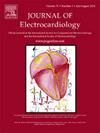杜氏肌营养不良患者心脏失调:心电图分析
IF 1.3
4区 医学
Q3 CARDIAC & CARDIOVASCULAR SYSTEMS
引用次数: 0
摘要
背景与目的杜氏肌营养不良症(DMD)是一种进行性x连锁隐性遗传病,以严重的肌肉变性和过早死亡为特征,通常由心脏并发症引起。尽管DMD中心律失常性心肌病的发病率很高,但心电图(ECG)分析在检测亚临床心脏失调方面的应用仍未得到充分探索。本研究旨在探讨DMD患儿II型导联心电图参数的改变,这可能表明心源性猝死(SCD)的风险升高。方法在这项横断面研究中,将54例基因证实的DMD患者的II型铅心电图记录与31例年龄匹配的健康对照进行比较。分析参数包括PR间期、QRS持续时间、QT和QTc间期、Tp-Te间期以及P、Q、R、S和T波振幅。采用LabChart Pro 8软件和Hamilton-Tompkins QRS检测算法进行分析。采用Bazett公式(QTc = QT/√RR)计算心率校正QT间期(QTc)。独立样本t检验,显著性水平为p <;组间比较采用0.05。结果与对照组相比,DMD组有明显的心电图改变,包括PR间期缩短,QRS和QT间期延长,QTc降低,Tp-Te间期增加。此外,观察到P、Q、R波振幅和ST波高度显著增加,表明心房肥厚和潜在的室性心律失常。结论:DMD患儿的slead II心电图分析显示出提示亚临床心脏失调的关键改变,强调了早期发现心脏受损伤的潜在非侵入性标志物。这些发现强调了DMD患者定期心脏监测的重要性,通过及时干预来降低SCD风险,并强调了进一步研究潜在病理生理机制的必要性。本文章由计算机程序翻译,如有差异,请以英文原文为准。
Cardiac dysregulation in Duchenne muscular dystrophy: An ECG analysis
Background and objective
Duchenne Muscular Dystrophy (DMD) is a progressive X-linked recessive disorder characterized by severe muscle degeneration and premature death, often due to cardiac complications. Despite the high prevalence of arrhythmogenic cardiomyopathy in DMD, the utility of Electrocardiogram (ECG) analysis in detecting subclinical cardiac dysregulation remains underexplored. This study aimed to investigate alterations in Lead II ECG parameters in children with DMD, potentially indicating an elevated risk of Sudden Cardiac Death (SCD).
Methods
In this cross-sectional study, Lead II ECG recordings from 54 genetically confirmed DMD patients were compared against 31 age-matched healthy-controls. Parameters analyzed included PR interval, QRS duration, QT and QTc intervals, Tp-Te interval, and amplitudes of P, Q, R, S, and T waves. Analysis was conducted using LabChart Pro 8 software and the Hamilton-Tompkins QRS detection algorithm. Heart-rate–corrected QT interval (QTc) was calculated using Bazett's formula (QTc = QT/√RR). An independent samples t-test with a significance level of p < 0.05 was used for comparisons between groups.
Results
The study revealed significant ECG alterations in the DMD group compared to controls, included a reduced PR interval, prolonged QRS and QT intervals, decreased QTc, and increased Tp-Te interval. Additionally, significant increases in P, Q, R wave amplitudes, and ST height were observed, indicative of atrial hypertrophy and potential ventricular arrhythmias.
Conclusions
Lead II ECG analysis in children with DMD demonstrates critical alterations suggestive of subclinical cardiac dysregulation, highlighting a potential non-invasive marker for early detection of cardiac involvement. These findings emphasize the importance of regular cardiac monitoring in DMD patients to mitigate SCD risk through timely interventions and underscore the need for further research into the underlying pathophysiological mechanisms.
求助全文
通过发布文献求助,成功后即可免费获取论文全文。
去求助
来源期刊

Journal of electrocardiology
医学-心血管系统
CiteScore
2.70
自引率
7.70%
发文量
152
审稿时长
38 days
期刊介绍:
The Journal of Electrocardiology is devoted exclusively to clinical and experimental studies of the electrical activities of the heart. It seeks to contribute significantly to the accuracy of diagnosis and prognosis and the effective treatment, prevention, or delay of heart disease. Editorial contents include electrocardiography, vectorcardiography, arrhythmias, membrane action potential, cardiac pacing, monitoring defibrillation, instrumentation, drug effects, and computer applications.
 求助内容:
求助内容: 应助结果提醒方式:
应助结果提醒方式:


